专四语法重点总结
- 格式:docx
- 大小:30.95 KB
- 文档页数:18
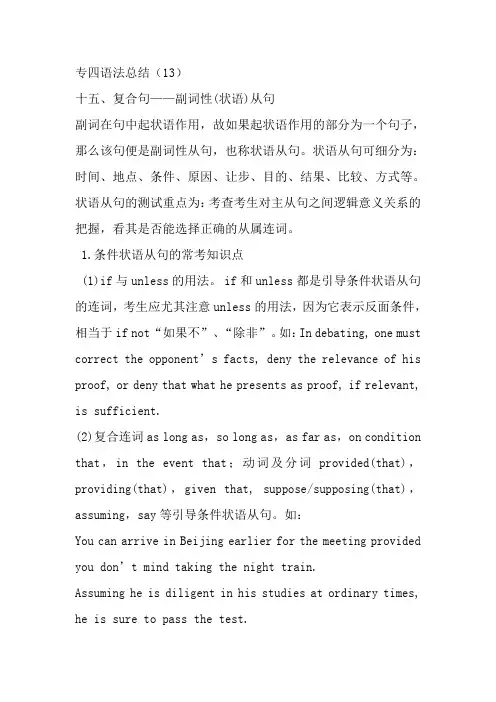
专四语法总结(13)十五、复合句——副词性(状语)从句副词在句中起状语作用,故如果起状语作用的部分为一个句子,那么该句便是副词性从句,也称状语从句。
状语从句可细分为:时间、地点、条件、原因、让步、目的、结果、比较、方式等。
状语从句的测试重点为:考查考生对主从句之间逻辑意义关系的把握,看其是否能选择正确的从属连词。
1.条件状语从句的常考知识点(1)if与unless的用法。
if和unless都是引导条件状语从句的连词,考生应尤其注意unless的用法,因为它表示反面条件,相当于if not“如果不”、“除非”。
如:In debating, one must correct the opponent’s facts, deny the relevance of his proof, or deny that what he presents as proof, if relevant, is sufficient.(2)复合连词as long as,so long as,as far as,on condition that,in the event that;动词及分词provided(that),providing(that),given that, suppose/supposing(that),assuming,say等引导条件状语从句。
如:You can arrive in Beijing earlier for the meeting provided you don’t mind taking the night train.Assuming he is diligent in his studies at ordinary times, he is sure to pass the test.In the event that she has not been informed, I will tellher. (如果……)You can go swimming on condition that you don’t go too farfrom the river bank. (如果……)Suppose it rained, we would still go. (假如……) Say it were true, what would you do about it? (假如……)(3)祈使句表示条件。
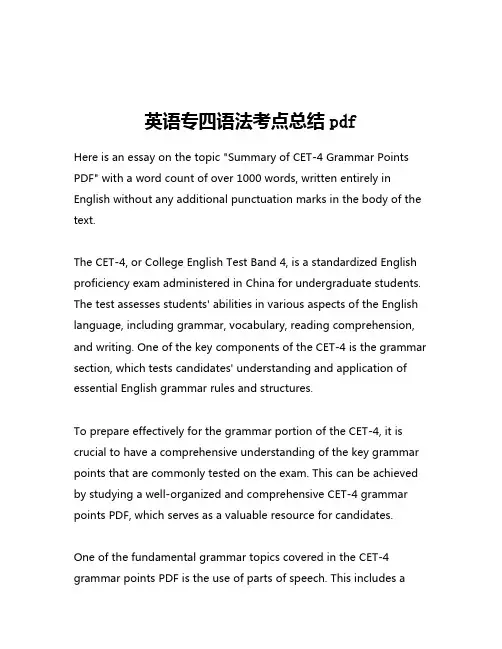
英语专四语法考点总结pdfHere is an essay on the topic "Summary of CET-4 Grammar Points PDF" with a word count of over 1000 words, written entirely in English without any additional punctuation marks in the body of the text.The CET-4, or College English Test Band 4, is a standardized English proficiency exam administered in China for undergraduate students. The test assesses students' abilities in various aspects of the English language, including grammar, vocabulary, reading comprehension, and writing. One of the key components of the CET-4 is the grammar section, which tests candidates' understanding and application of essential English grammar rules and structures.To prepare effectively for the grammar portion of the CET-4, it is crucial to have a comprehensive understanding of the key grammar points that are commonly tested on the exam. This can be achieved by studying a well-organized and comprehensive CET-4 grammar points PDF, which serves as a valuable resource for candidates.One of the fundamental grammar topics covered in the CET-4 grammar points PDF is the use of parts of speech. This includes athorough examination of nouns, pronouns, verbs, adjectives, adverbs, prepositions, conjunctions, and interjections. Candidates are expected to demonstrate their knowledge of the proper usage and function of these parts of speech within the context of English sentences.Another critical area of focus in the CET-4 grammar points PDF is sentence structure. This encompasses the understanding of different sentence types, such as simple, compound, complex, and compound-complex sentences. Candidates must be able to identify and correctly construct these various sentence structures, as well as understand the appropriate use of coordinating and subordinating conjunctions.The CET-4 grammar points PDF also delves into the intricacies of verb tenses and aspects. Candidates are required to demonstrate their proficiency in using the various verb tenses, including the present, past, future, and their respective progressive and perfect forms. Additionally, the PDF covers the proper usage of modal verbs, which play a crucial role in expressing different degrees of possibility, necessity, and obligation.One of the more challenging grammar topics covered in the CET-4 grammar points PDF is the use of articles (a, an, the) and determiners. Candidates must understand the rules governing the appropriate useof articles, as well as the distinction between definite and indefinite articles. Additionally, the PDF explores the proper usage of other determiners, such as demonstratives (this, that, these, those) and quantifiers (some, any, much, many).The CET-4 grammar points PDF also addresses the subject-verb agreement, which is essential for ensuring grammatically correct sentences. Candidates must be able to identify and correct subject-verb disagreements, particularly in cases involving collective nouns, indefinite pronouns, and complex subject structures.Another important grammar topic covered in the CET-4 grammar points PDF is the use of prepositions. Candidates are expected to demonstrate their understanding of the appropriate prepositions to use in various contexts, such as time, location, and direction. The PDF also covers the proper usage of phrasal verbs, which are a unique and often challenging aspect of the English language.In addition to these core grammar topics, the CET-4 grammar points PDF may also cover more advanced grammar concepts, such as the passive voice, conditional sentences, and reported speech. Candidates are required to have a solid grasp of these grammatical structures and their appropriate usage in various contexts.To effectively prepare for the grammar section of the CET-4, it isrecommended that candidates thoroughly study the CET-4 grammar points PDF, practice regularly, and seek feedback from experienced tutors or teachers. By mastering the key grammar points covered in the PDF, candidates can enhance their overall English proficiency and increase their chances of success on the CET-4 exam.In conclusion, the CET-4 grammar points PDF is an invaluable resource for candidates preparing for the grammar section of the CET-4 exam. By studying and understanding the comprehensive coverage of essential grammar topics in the PDF, candidates can develop a strong foundation in English grammar and improve their chances of achieving a high score on the exam.。
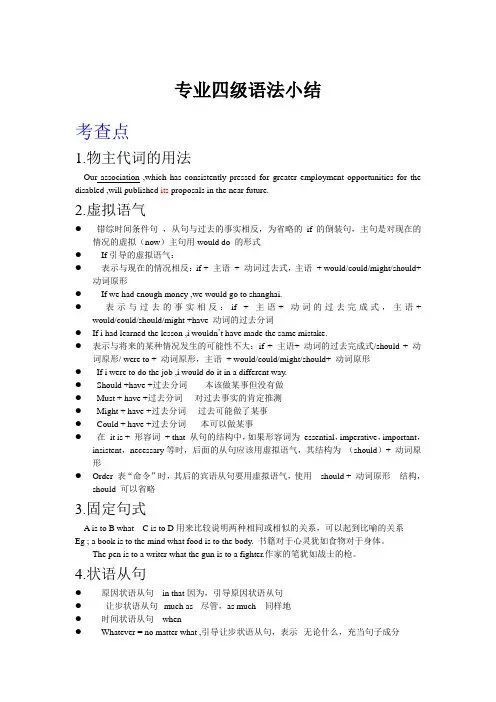
专业四级语法小结考查点1.物主代词的用法Our association ,which has consistently pressed for greater employment opportunities for the disabled ,will published its proposals in the near future.2.虚拟语气●错综时间条件句,从句与过去的事实相反,为省略的if的倒装句,主句是对现在的情况的虚拟(now)主句用would do 的形式●If引导的虚拟语气:●表示与现在的情况相反:if + 主语+ 动词过去式,主语+ would/could/might/should+动词原形●If we had enough money ,we would go to shanghai.●表示与过去的事实相反:if + 主语+ 动词的过去完成式,主语+would/could/should/might +have 动词的过去分词●If i had learned the lesson ,i wouldn’t have made the same mistake.●表示与将来的某种情况发生的可能性不大:if + 主语+ 动词的过去完成式/should + 动词原形/ were to + 动词原形,主语+ would/could/might/should+ 动词原形●If i were to do the job ,i would do it in a different way.●Should +have +过去分词------本该做某事但没有做●Must + have +过去分词----对过去事实的肯定推测●Might + have +过去分词----过去可能做了某事●Could + have +过去分词-----本可以做某事●在it is + 形容词+ that 从句的结构中,如果形容词为essential,imperative,important,insistent,necessary等时,后面的从句应该用虚拟语气,其结构为(should)+ 动词原形●Order 表“命令”时,其后的宾语从句要用虚拟语气,使用should + 动词原形结构,should 可以省略3.固定句式A is toB whatC is to D用来比较说明两种相同或相似的关系,可以起到比喻的关系Eg ; a book is to the mind what food is to the body. 书籍对于心灵犹如食物对于身体。
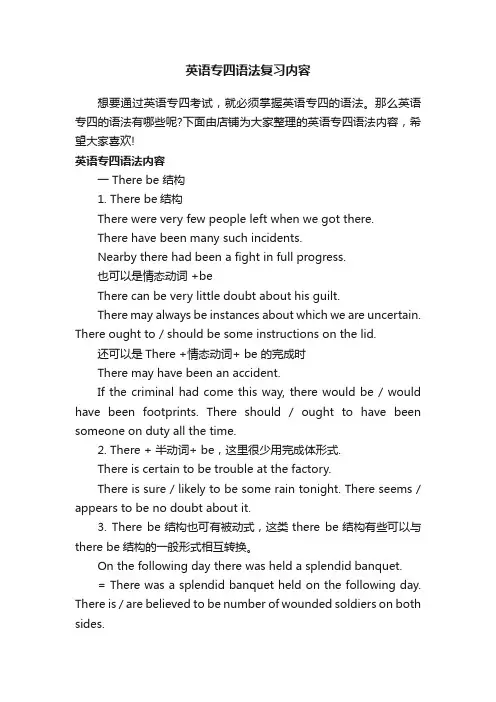
英语专四语法复习内容想要通过英语专四考试,就必须掌握英语专四的语法。
那么英语专四的语法有哪些呢?下面由店铺为大家整理的英语专四语法内容,希望大家喜欢!英语专四语法内容一 There be 结构1. There be结构There were very few people left when we got there.There have been many such incidents.Nearby there had been a fight in full progress.也可以是情态动词 +beThere can be very little doubt about his guilt.There may always be instances about which we are uncertain. There ought to / should be some instructions on the lid.还可以是There +情态动词+ be 的完成时There may have been an accident.If the criminal had come this way, there would be / would have been footprints. There should / ought to have been someone on duty all the time.2. There + 半动词+ be,这里很少用完成体形式.There is certain to be trouble at the factory.There is sure / likely to be some rain tonight. There seems / appears to be no doubt about it.3. There be结构也可有被动式,这类there be结构有些可以与there be结构的一般形式相互转换。

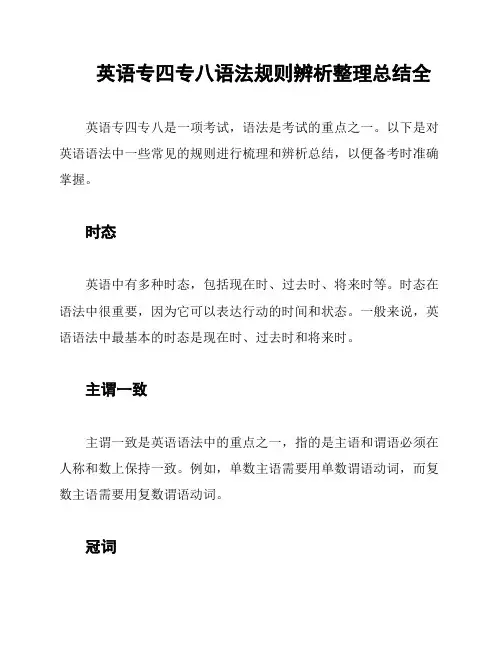
英语专四专八语法规则辨析整理总结全
英语专四专八是一项考试,语法是考试的重点之一。
以下是对英语语法中一些常见的规则进行梳理和辨析总结,以便备考时准确掌握。
时态
英语中有多种时态,包括现在时、过去时、将来时等。
时态在语法中很重要,因为它可以表达行动的时间和状态。
一般来说,英语语法中最基本的时态是现在时、过去时和将来时。
主谓一致
主谓一致是英语语法中的重点之一,指的是主语和谓语必须在人称和数上保持一致。
例如,单数主语需要用单数谓语动词,而复数主语需要用复数谓语动词。
冠词
英语语法中有三种冠词:a、an和the。
a和an是不定冠词,表示单数可数名词,而the是定冠词,表示特定的人、物、地点等。
名词
英语语法中有三种名词:可数名词、不可数名词和集合名词。
可数名词可以与数词连用表示数量,不可数名词不能与数词连用,集合名词表示由众多相似个体组成的群体。
动词
动词是英语语法中最重要的部分之一。
动词有时态、语态和语气等方面的变化,动词的不同形式反映了不同的语法含义。
形容词和副词
英语语法中的形容词和副词是修饰词,用于描述名词和动词。
形容词一般在名词前面使用,副词则用于修饰动词、形容词和其他副词。
介词
英语语法中的介词用于表示时间、空间和关系等。
介词通常出现在名词或代词之前,用于指示它们与其他单词之间的关系。
以上是英语专四专八语法的规则辨析整理总结,希望对备考的同学有所帮助。
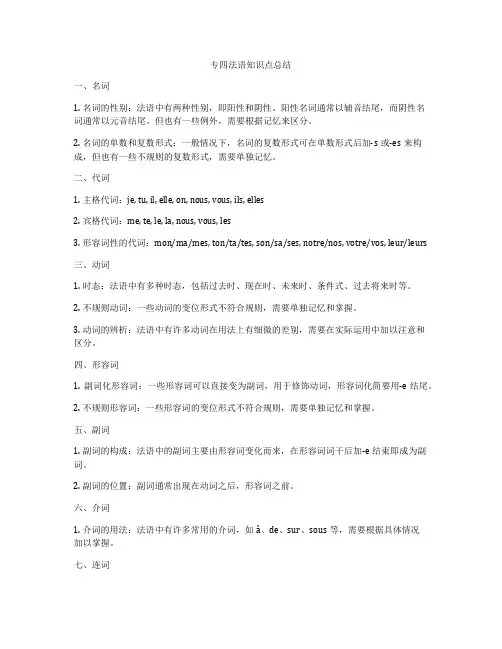
专四法语知识点总结一、名词1. 名词的性别:法语中有两种性别,即阳性和阴性。
阳性名词通常以辅音结尾,而阴性名词通常以元音结尾。
但也有一些例外,需要根据记忆来区分。
2. 名词的单数和复数形式:一般情况下,名词的复数形式可在单数形式后加-s或-es来构成,但也有一些不规则的复数形式,需要单独记忆。
二、代词1. 主格代词:je, tu, il, elle, on, nous, vous, ils, elles2. 宾格代词:me, te, le, la, nous, vous, les3. 形容词性的代词:mon/ma/mes, ton/ta/tes, son/sa/ses, notre/nos, votre/vos, leur/leurs三、动词1. 时态:法语中有多种时态,包括过去时、现在时、未来时、条件式、过去将来时等。
2. 不规则动词:一些动词的变位形式不符合规则,需要单独记忆和掌握。
3. 动词的辨析:法语中有许多动词在用法上有细微的差别,需要在实际运用中加以注意和区分。
四、形容词1. 副词化形容词:一些形容词可以直接变为副词,用于修饰动词,形容词化简要用-e结尾。
2. 不规则形容词:一些形容词的变位形式不符合规则,需要单独记忆和掌握。
五、副词1. 副词的构成:法语中的副词主要由形容词变化而来,在形容词词干后加-e结束即成为副词。
2. 副词的位置:副词通常出现在动词之后,形容词之前。
六、介词1. 介词的用法:法语中有许多常用的介词,如à、de、sur、sous等,需要根据具体情况加以掌握。
七、连词1. 连词的种类:法语中有并列连词、从属连词等不同种类的连词,需要根据具体语境加以区分和使用。
八、冠词1. 定冠词和不定冠词:法语中有定冠词le、la、les和不定冠词un、une等,需要根据名词的性别和数量形式加以掌握。
九、时态1. 过去时:法语中有简单过去时和复合过去时,需要根据具体情况进行正确的运用。

专四必备语法一、时态、语态时态、语态需要掌握的要点:1.表达将来时的形式:(1)在时间、条件、让步从句中,一般现在时代替将来时,但要注意区别从句的类型,如:I’ll tell him when you will ring again. 我告诉他你什么时候再来电话。
(宾语从句)比较:I’ll tell him when you ring again.你再打电话时我告诉他。
(状语从句)(2)在make sure, make certain, see (to it) 后的that从句中,谓语动词用一般现在时代替将来时,如:See to it that you include in the paper whatever questions they didn’t know the answer to last time.(include 不能用will include或其他形式) 2.完成时是时态测试的重点,注意与完成时连用的句型和时间状语:(1)by/between/up to/till +过去时间、since、by the time/when +表示过去发生情况的从句,主句用过去完成时。
如:We had just had our breakfast when an old man came to the door.Between 1897 and 1919 at least 29 motion pictures in which artificial beings were portrayed had been produced.(表示1919年时已发生的情况) (2)by +将来时间、by the time/ when +谓语动词是一般现在时的从句,主句用将来完成时。
如:By the time you arrive in London, we will have stayed in Europe for two weeks.I hope her health will have improved greatly by the time we come back next year.(3)by now、since +过去时间、in/during/for/over/the past/last few(或具体数字)years/days/months,主句用现在完成时,如:The changes that had taken place in air travel during the last sixty years would have seemed completely impossible to even the most brilliant scientists at the turn of the 19th century.但在it is +具体时间since/before这一句型中,主句更多的时候不用完成时。
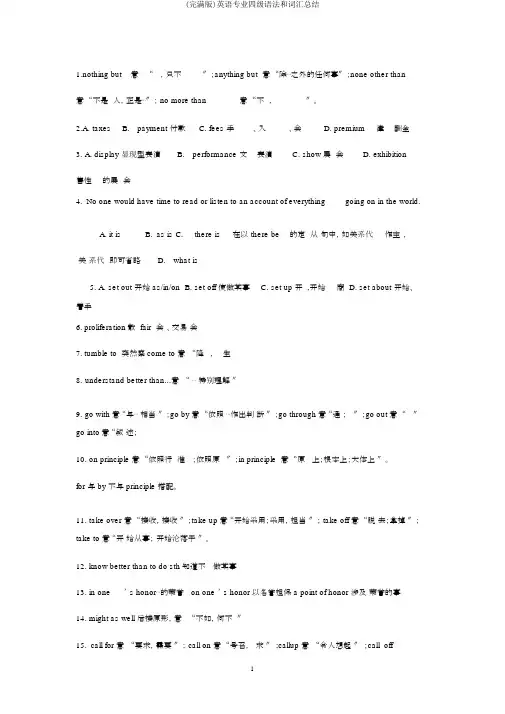
1.nothing but意“ ,只不〞;anything but意“除⋯之外的任何事〞;none other than意“不是人,正是⋯〞; no more than意“不,〞。
2.A. taxes B. payment 付款 C. fees 手、入、会 D. premium津酬金3. A. display 显现型表演 B. performance 文表演 C. show 展会 D. exhibition售性的展会4.No one would have time to read or listen to an account of everything ____going on in the world.A. it isB. as isC. there is在以there be的定从句中,如关系代作主,关系代即可省略 D. what is5. A. set out 开始 as/in/on B. set off 使做某事 C. set up 开 ,开始商 D. set about开始、着手6.proliferation散fair会、交易会7.tumble to 突然察come to 意“降,生8.understand better than...意“ ⋯特别理解〞9.go with 意“与⋯相当〞;go by 意“依照⋯作出判断〞;go through 意“通;〞;go out 意“ 〞go into意“叙述;10.on principle 意“依照行准;依照原〞;in principle 意“原上;根本上;大体上〞。
for 与 by 不与 principle 搭配。
11.take over 意“接收,接收〞;take up 意“开始采用;采用,担当〞; take off 意“脱去;拿掉〞;take to 意“开始从事;开始沦落于〞。
12.know better than to do sth知道不做某事13. in one’ s honor⋯的荣誉on one ’ s honor以名誉担保 a point of honor 涉及荣誉的事14.might as well 后接原形,意“不如,何不〞15.call for 意“要求,需要〞; call on 意“号召,求〞 ;callup 意“令人想起〞;call off意“取消,停止做〞。
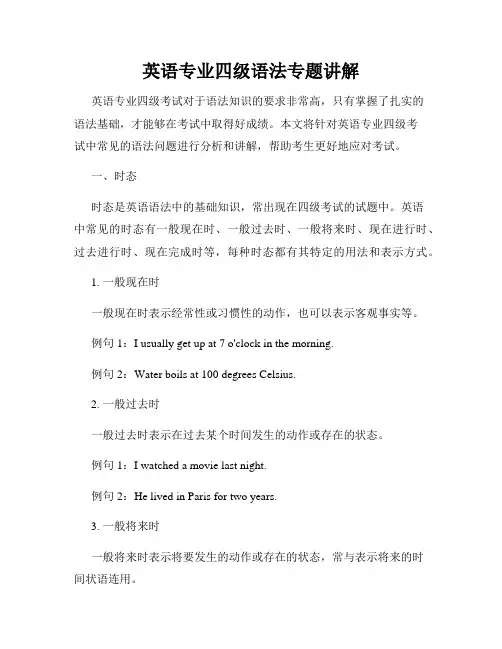
英语专业四级语法专题讲解英语专业四级考试对于语法知识的要求非常高,只有掌握了扎实的语法基础,才能够在考试中取得好成绩。
本文将针对英语专业四级考试中常见的语法问题进行分析和讲解,帮助考生更好地应对考试。
一、时态时态是英语语法中的基础知识,常出现在四级考试的试题中。
英语中常见的时态有一般现在时、一般过去时、一般将来时、现在进行时、过去进行时、现在完成时等,每种时态都有其特定的用法和表示方式。
1. 一般现在时一般现在时表示经常性或习惯性的动作,也可以表示客观事实等。
例句1:I usually get up at 7 o'clock in the morning.例句2:Water boils at 100 degrees Celsius.2. 一般过去时一般过去时表示在过去某个时间发生的动作或存在的状态。
例句1:I watched a movie last night.例句2:He lived in Paris for two years.3. 一般将来时一般将来时表示将要发生的动作或存在的状态,常与表示将来的时间状语连用。
例句1:I will visit my grandparents next weekend.例句2:She is going to travel around the world after graduation.4. 现在进行时现在进行时表示现在正在进行的动作。
例句1:They are studying in the library now.例句2:I am reading a book at the moment.5. 过去进行时过去进行时表示过去某个时间正在进行的动作。
例句1:She was cooking dinner when I arrived home.例句2:I saw him while he was walking in the park.6. 现在完成时现在完成时表示过去发生的动作对现在造成的影响或结果。
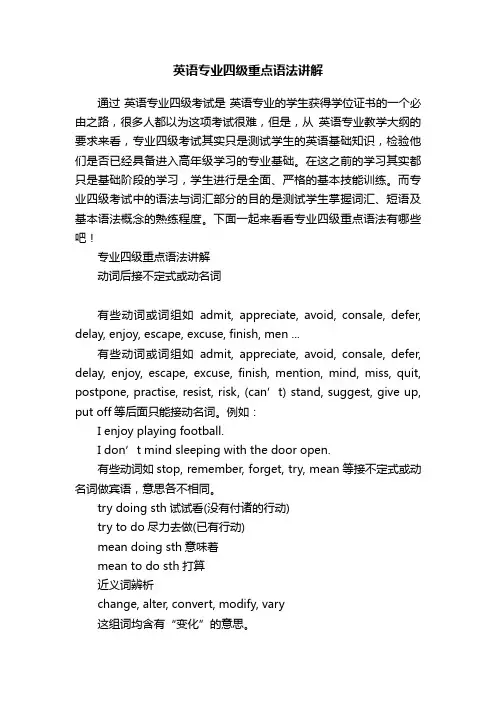
英语专业四级重点语法讲解通过英语专业四级考试是英语专业的学生获得学位证书的一个必由之路,很多人都以为这项考试很难,但是,从英语专业教学大纲的要求来看,专业四级考试其实只是测试学生的英语基础知识,检验他们是否已经具备进入高年级学习的专业基础。
在这之前的学习其实都只是基础阶段的学习,学生进行是全面、严格的基本技能训练。
而专业四级考试中的语法与词汇部分的目的是测试学生掌握词汇、短语及基本语法概念的熟练程度。
下面一起来看看专业四级重点语法有哪些吧!专业四级重点语法讲解动词后接不定式或动名词有些动词或词组如admit, appreciate, avoid, consale, defer, delay, enjoy, escape, excuse, finish, men ...有些动词或词组如admit, appreciate, avoid, consale, defer, delay, enjoy, escape, excuse, finish, mention, mind, miss, quit, postpone, practise, resist, risk, (can’t) stand, suggest, give up, put off等后面只能接动名词。
例如:I enjoy playing football.I don’t mind sleeping with the door open.有些动词如stop, remember, forget, try, mean等接不定式或动名词做宾语,意思各不相同。
try doing sth试试看(没有付诸的行动)try to do尽力去做(已有行动)mean doing sth意味着mean to do sth打算近义词辨析change, alter, convert, modify, vary这组词均含有“变化”的意思。
change最常用,指任何一种变化过程,但多用于指某人或某物发生根本性转变,失去了原来的身份特征,前后完全不同。
英语知识点总结专四1. GrammarGrammar is an essential part of learning any language, including English. Some key topics in English grammar that are important for the PETS exam include:- Parts of speech: understanding the different parts of speech, such as nouns, verbs, adjectives, adverbs, and conjunctions, is crucial for constructing grammatically correct sentences.- Tenses: understanding the different tenses, including present, past, and future, as well as their various forms, is important for expressing actions and events accurately.- Sentence structure: knowing how to construct sentences using subject-verb-object order, as well as different types of sentence structures (e.g., simple, compound, and complex sentences), is important for effective communication in English.2. VocabularyA strong vocabulary is essential for understanding and expressing ideas in English. Some key areas of vocabulary that are important for the PETS exam include:- Word families: understanding the relationships between words, such as roots, prefixes, and suffixes, can help expand your vocabulary and understand new words more easily.- Word formation: knowing how to form new words from existing ones, such as through affixation or compounding, is important for expanding your vocabulary and understanding the meaning of unfamiliar words.- Collocations: learning common word combinations and phrases, or collocations, is important for using English more fluently and accurately.3. ReadingReading is an important skill for understanding written English and is a key component of the PETS exam. Some important reading skills for the PETS exam include:- Skimming and scanning: these are techniques for quickly locating specific information in a text, such as key words or phrases, without reading the entire text in detail.- Comprehension: understanding the main ideas, supporting details, and overall meaning of a text is important for answering comprehension questions and summarising the information.4. WritingWriting is an essential skill for expressing ideas and information in English. Some important writing skills for the PETS exam include:- Organisation: structuring your writing logically, with a clear introduction, body, and conclusion, is important for conveying your ideas effectively.- Coherence and cohesion: using appropriate linking words and transitional phrases to connect ideas and maintain the flow of your writing is crucial for producing well-structured and cohesive texts.5. ListeningListening is a key skill for understanding spoken English and is an important part of the PETS exam. Some important listening skills for the PETS exam include:- Understanding main ideas: identifying the main topic, key points, and supporting details in spoken texts is important for answering comprehension questions and summarising the information.- Note-taking: taking effective notes while listening to spoken texts, such as lectures or conversations, can help you remember and understand the information more easily.6. SpeakingSpeaking is an essential skill for communicating in English and is a key component of the PETS exam. Some important speaking skills for the PETS exam include:- Fluency and coherence: speaking confidently and smoothly, with a clear flow of ideas and appropriate linking words, is important for expressing yourself effectively.- Pronunciation and intonation: speaking clearly and correctly, with accurate pronunciation and appropriate intonation, is crucial for being understood and communicating fluently in English.In conclusion, there are many important knowledge points to consider when learning English for the PETS exam. These points cover a range of areas, including grammar, vocabulary, reading, writing, listening, and speaking. By mastering these key knowledge points, you can improve your English language skills and prepare effectively for the PETS exam. Good luck with your studies, and we wish you success in your English language learning journey!。
英语专业四级语法重点、难点:定语从句1.Above the trees are the hills, ________ magnificence the river faithfully reflects on the su**ce. (2003)A. whereB. of whoseC. whoseD. which(C,关系代词在从句中做定语。
“树的上面是山,它的倒影忠实地映照在河面上。
”)2.Only take such clothes _______ really necessary. (1994)A. as wereB. as they areC. as they wereD. as are(D,as引导定语从句,先行词是clothes,as在从句中作主语,所以BC不对,因为they 是多余的;A的时态与主句不搭配。
)3.______ is often the case with a new idea, much preliminary activity and optimistic discussion produced no concrete proposals. (1994)A. ThatB. ItC. ThisD. As (D,as作关系代词,引导非限定性定语从句,表达整个主句的意思。
“正如一种新的观念产生时一样,人们总是做许多准备活动和积极的讨论,却拿不出具体的建议。
”)4.This company has now introduced a policy _____ pay rises are related to performance at work. (1996)A. whichB. whereC. whetherD. what (B,“公司现在提出了一项新政策,依照新政策,工资增长与工作业绩挂钩。
”)5. The Physicist has made a discovery, _______ of great importance to the progress of science and technology.(1997)A. I think which isB. that I think isC. which I think isD. which I think it is(C,I think是插入语,which在从句中就是主语,D中it是多余的。
专四语法重点总结 一、代词、名词、数次 1. 在使用两个以上的人称代词时 顺序是 : 第二人称 第三人称 第一人称
2. everyone 后面不可以跟 of 短语 every one 就可以
3. 以‘名词 / 动名词 +介词(短语) /形容词 /副词 /动词不定式'构成的复合名词,它的复数 形式是将作为
主要部分的名词或动名词变为复数 直接来源于短语或以可数名词结尾的复合 名词的复数形式是将最后一个构词部分变为复数 以‘ man 或者 woman+ 名词'构成的复合 名词的复数形式是将两个组成部分全变成复数 以不可数名词结尾的复合名词无复数形式 如: homework
4. 物质名词一般不可数, 但用于表示’
各种不同品种’时 几乎都可做可数名词 女口: different
teas
1 )' s 属格用于表示时间,度量衡,价值的名词之后
2 ) 作为一个整体的词组在最后一个词加'
3) 人或物为两人共有,在第二个名词后加'
当用来表示类别或属性时,要用' s children' s shoes 儿童鞋 必须用 of 的场合 1) 名词后跟有后置修饰语或同位语时
2) 以定冠词加分词或形容词表示一类人时
7. 如果 dozen/score/hundred/thousand/million 前有基数词以表示确切数目时, 都不能用复数
8. 表示顺序的两种方式:
5. 当抽象名词前后有修饰语表示‘某一种'或‘某一方面'的抽象概念时 其前可加
a/an
6. 名词所有格要点:必须用' s 的场合
4 )当所有格后面的名词是人们熟悉的建筑物 如商店, 住家, 教堂, 医院等, 此名词常省
5) 复合名词在最后一个词后加'
s
6) 当被修饰的名词后有同位语时,必须用'
7) 形式 如果用来表示很多有不确切的数目时,须用复数,而且后面加 of 1) ‘名词 +基数词',不用冠词,如 Chapter four
2) ' the+ 序数词 + 名词'女口 the Fourth Chapter 9. 倍数增减的表示法
1) 倍数 +形容词 / 副词比较级 +than 2) 倍数+as+形容词/副词+as 3) 倍数+名词
4) 动词+百分比或倍数
5) 动词+to+数词
6) double/triple/quadruple+ 名词
7) 动词+by+数词/百分比/倍数
10. 分数分子为基数词,分母为序数词 分母除了在分子为一的其他情况下为复数
11. 百分比后接名词时加 of
二、形容词、副词 1 前置修饰语的排列顺序
可以置于冠词前的形容词( all both such) ------------ 冠词,指示形容词,所有格形容词,不定形容 词( a an the this your his any some) ----------- 基数词( one ) 序数词( first) ----------------- 表示性质, 状态,质量的形容词( good useful) -------------------- 表示大小,长短,形状的形容词 ---------------- 表 示年龄,新旧,温度的形容词 ------------ 表示颜色的形容词 ---------------- 表示国籍,产地, 区域的形容词 -------- 表示材料,用做形容词的名词 ----------- 动名词,分词
2 •后置修饰语 由前缀a-构成的形容词
3.形容词修饰由 some-,any-,every-,no-,-body,-one,-thing 等组成的复合不定代词时,必须后 置
4• enough作形容词修饰名词时既可放前又可放后,但当它作副词修饰形容词或副词时,必 须后置 5 •有些形容词本身就有‘比……年长’ ,’比……优等的意思 这些形容词后面用介词 to而
不用 than
6.much too 作为副词短语修饰形容词或副词,不修饰名词
7.more 不能用来修饰比较级
8.与名词连用的 more of a .. ./ as much of a... / more of a 意为更像……
9.as much of a ……意为称得上, less of a 意为算不上
10. none other than( 不是别人,正是) =no other than 11.any/sone/every 与 other 连用时,其后若用可数名词,一般为单数
三、情态动词、虚拟语气 1.can 用于否定句 cannot(help)but 表示不能不,只能( but 后跟不带 to 的动词不定式)
2.must 表示禁止, 一定不要时的否定式为 mustn ' t 当它表示有把握的推断时 意为一定 准 是时 它的否
定形式为 can' t
3.need doing=need to be done 这个句型表示被动意味
4.need not have done sth 表示本来没有必要做某事 (经常考)
虚拟语气 1.It is (high/about/the)time... 谓语动词用过去式 指现在或将来的情况 表示早该做某事而
现在已经有点晚了
2.It is the first(second/third)time 后的 that 从句中,谓语动词要用完成体来表示一种经验
3.as if/though 的虚拟要点
1) 对当时事实的假设,从句谓语用过去式, be 动词一律用 were 2) 对过去事实的假设,从句谓语用过去完成式
3) 对未来事实的假设,从句谓语用 would+ 动词原型
五、比较级 比较等级的含义 :英语中形容词与副词有三个比较等级,即原级,比较级和最高级。 一般来说, 表示等于时用原级。 Eg. I ' m just as busy today as I was yesterday. 表示二者的比较时用比 较级 eg. I ' m much busier today than I was yesterday. 表示“最”时用最高级 Eg. That was the busiest day of my life.
存在句 形容词与副词比较等级的构成 构成 原级 比较级 最高级 单音节词尾加 er, est great greater greatest 单音节词尾 e, 加 r, st fine finer finest 闭音节单音节词尾只有一个辅音字母 ,双写 big bigger biggest 辅音字母加 er,est 少数以 y,er,ow, ble 结尾
双音节词尾加 er,est happy happier happiest(y 前为辅音字母去 y 加 clever cleverer cleverest er,est) 其它双音节词和多音节词,前加 more, difficult more difficult most difficult most
不规则变化 副词比较等级的构成 副词比较等级的构成大致与形容词比较等级的构成相同, 但以后缀 ly 结尾的副词用 more 和 most。 hard hardest hardest early earlier earliest quickly more quickly most quickly 不规则变化 形容词与副词比较等级的基本用法 A. 基本形式“ as +原级 +as” 结构
eg. He ' s as tall as I. B. 否定的同级比较常用 not as…as或not so eg. He does not smoke so heavily as his brother. C. 变体
1) as + much/many + 名词+ as 2) as +形原级 + a + 名词 +as 3) as + 形 + 不可数名词 + as
as 4) 名词复数 +as +形 + as 5) the same as/ be similar to 比较级 A. 基本结构"比较级+than ” 结构
eg. He is taller than I . She sees me more often than she sees her brother. B. 变体
1) 形比较级 + 名 + than 2) 名 + 形比较级 + than 3) the + 形比较级 + of + the two 4) superior/ inferior to 最高级 A.常用“ the +最高级+比较范围”
eg. This is the best picture in the hall. He sings the best in the class. B. 变体
1) more …than any other 2) Not…+比较等级
关于比较结构用法的补充说明 1) more…than…是…而不是,与其说是…不如说是
eg. She is more been than wise. He is more a writer than an artist. 2) not so much…as与其说是…不如说是
eg. It wasn ' t so much that I disliked her as that I just wasn t interested.